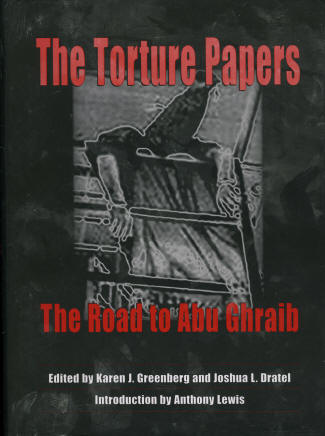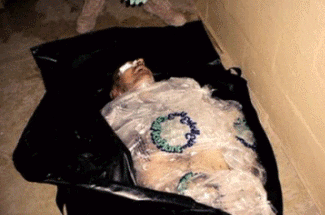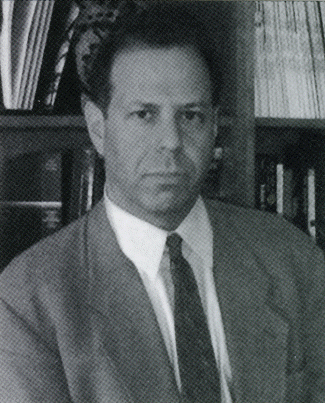Edited by Karen J. Greenberg, Joshua L. Dratel, Introduction by Anthony Lewis
© Karen J. Greenberg and Joshua L. Dratel 2005
NOTICE: THIS WORK MAY BE PROTECTED BY COPYRIGHT
YOU ARE REQUIRED TO READ THE COPYRIGHT NOTICE AT THIS LINK BEFORE YOU READ THE FOLLOWING WORK, THAT IS AVAILABLE SOLELY FOR PRIVATE STUDY, SCHOLARSHIP OR RESEARCH PURSUANT TO 17 U.S.C. SECTION 107 AND 108. IN THE EVENT THAT THE LIBRARY DETERMINES THAT UNLAWFUL COPYING OF THIS WORK HAS OCCURRED, THE LIBRARY HAS THE RIGHT TO BLOCK THE I.P. ADDRESS AT WHICH THE UNLAWFUL COPYING APPEARED TO HAVE OCCURRED. THANK YOU FOR RESPECTING THE RIGHTS OF COPYRIGHT OWNERS.

"Self-defense is a common-law defense to federal criminal offenses, and nothing in the text, structure or history of section 2340A precludes its application to a charge of torture ... If hurting him is the only means to prevent the death or injury of others put at risk by his actions, such torture should be permissible."
-- Memorandum for William J. Haynes, II, from John C. Yoo, 3/14/03
***
"Every act constituting torture under the Convention constitutes a criminal offense under the law of the United States. No official of the Government, federal, state or local, civilian or military, is authorized to commit or to instruct anyone else to commit torture. Nor may any official condone or tolerate torture in any form. No exceptional circumstances may be invoked as justification for torture. United States law contains no provision permitting otherwise prohibited acts of torture or other cruel, inhuman or degrading treatment or punishment to be employed on grounds of exigent circumstance (for example, during a “state of public emergency”) or on orders from a superior officer or public authority, and the protective mechanisms of an independent judiciary are not subject to suspension."
-- "United States report to the U.N. Committee Against Torture," 1999 cited in The Association of the Bar of the City of New York, Committee on International Human Rights, and Committee on Military Affairs and Justice’s Report
***
"The prohibition of torture is, moreover, one of the few norms which has attained peremptory norm or jus cogens status, and is recognized as such by United States courts. Jus cogens is defined as a peremptory norm “accepted and recognized by the international community of states as a whole as a norm from which no derogation is permitted and which can be modified only by a subsequent norm of general international law having the same character.”
-- American Bar Association Report to the House of Delegates Re: Uses of Torture
***
“A democratic, freedom-loving society does not accept that investigators use any means for the purpose of uncovering the truth. The interrogations practices of the police in a given regime are indicative of a regime’s very character."
-- Israeli Supreme Court, "Judgment Concerning The Legality Of The General Security Service’s Interrogation Methods," cited in The Association of the Bar of the City of New York, Committee on International Human Rights, and Committee on Military Affairs and Justice’s Report
***
"The use of torture and cruel, inhuman or degrading treatment by United States personnel in the interrogation of prisoners captured in the Afghanistan and Iraq conflicts has brought shame on the nation and undermined our standing in the world. While the U.S. government has acknowledged, and is moving to punish, the acts at Abu Ghraib that have been documented on videotape, this does not address the substantial, fundamental concerns regarding U.S. interrogation policy and the treatment of detainees.
"The U.S. government maintains that its policies comport with the requirements of law, and that the violations at Abu Ghraib represent isolated instances of individual misconduct. But there apparently has been a widespread pattern of abusive detention methods. Executive Branch memoranda were developed to justify interrogation procedures that are in conflict with long-held interpretations and understandings of the reach of treaties and laws governing treatment of detainees. Whether and to what extent the memoranda were relied upon by U.S. officials may be open to question, but it is clear that those legal interpretations do not represent sound policy, risk undercutting the government’s ability to assert any high moral ground in its “war on terrorism”, and put Americans at risk of being tortured or subjected to cruel, inhuman or degrading treatment by governments and others willing to cite U.S. actions as a pretext for their own misconduct."
-- American Bar Association Report to the House of Delegates Re: Uses of Torture
***
"In its Report on the Treatment by the Coalition Forces of Prisoners of War and other protected persons in Iraq, the International Committee of the Red Cross (ICRC) draws the attention of the Coalition Forces to a number of serious violations of International Humanitarian Law: .... (1) Brutality against protected persons upon capture and initial custody, sometimes causing death or serious injury; (2) Physical or psychological coercion during interrogation to secure information; (3) Prolonged solitary confinement in cells devoid of daylight;
(4) Excessive and disproportionate use of force against persons deprived of their liberty resulting in death or injury during their period of internment."
-- Report of the International Committee of the Red Cross (ICRC) on the Treatment by the Coalition Forces of Prisoners of War and Other Protected Persons by the Geneva Conventions in Iraq During Arrest, Internment and Interrogation
***
On 6 September 2006, President Bush publicly announced that fourteen “high value” detainees had been transferred from the High Value Detainee Program run by the Central Intelligence Agency (hereafter CIA detention program) to the custody of the Department of Defense in Guantanamo Bay Internment Facility (hereafter Guantanamo). The fourteen detainees (hereafter the fourteen) were reportedly held in the CIA detention program from the time of their arrest, or shortly thereafter, until their arrival in Guantanamo. Throughout their time in CIA custody—which ranges from 16 months to almost four and a half years—these persons were held in undisclosed detention. Prior to this public announcement, the ICRC had never been informed by the US authorities of the existence of the CIA detention program, nor of the presence in US custody of the fourteen. This is despite the fact that thirteen of the fourteen had been included in the above-mentioned ICRC written requests to the US authorities concerning undisclosed detention, the first of which were made in January 2003. The remaining detainee was not known to the ICRC. ...
In the ICRC’s view, the fourteen were placed outside the protection of the law during the time they spent in CIA custody. Indeed, one of the main effects of the transfers was to place the fourteen in secret detention facilities in unspecified locations in a number of different countries, outside the reach of any judicial or administrative system. As such, they were, for instance, apparently both precluded from knowing the reasons for their detention and denied access to any mechanism capable of independently reviewing the lawfulness of their detention. They were also denied contact with their families, including any information to the families of their detention. The totality of the circumstances in which the fourteen were held effectively amounted to an arbitrary deprivation of liberty and enforced disappearance, in contravention of international law.
As regards conditions of detention and treatment of the fourteen, the effects of their being in undisclosed detention were severe and multifaceted, as the present report shows. The absence of scrutiny by any independent entity—including the ICRC— inevitably creates conditions conducive to excesses that would not otherwise be permitted. Persons held in undisclosed detention are especially vulnerable to being subjected to ill-treatment. Indeed, the allegations of the fourteen include descriptions of treatment and interrogation techniques—singly or in combination—that amounted to torture and/or cruel, inhuman or degrading treatment.
-- Report of the International Committee of the Red Cross (ICRC) on the Treatment of Fourteen "High Value Detainees" in CIA Custody
***
"Abuses at Abu Ghraib and elsewhere are strong evidence that in the war on terror this nation’s detention policies have lost their moral compass. Rather than seek to excuse or minimize these failings, the U.S. must take responsibility for violations of treaties and international law, condemn those violations, investigate all plausible allegations of violations, and punish all those responsible, no matter how high ranking. It is vital to ensure that this disgraceful behavior does not happen again. Any individual who alleges that he or she has been subjected to torture must be provided with a meaningful opportunity to complain to, and to have his/her case promptly and impartially examined by, competent authorities."
-- American Bar Association Report to the House of Delegates Re: Uses of Torture
"18 U.S.C. § 2340A–torture or attempted torture committed outside the United States by a person acting under color of law, where death results. United States jurisdiction under this provision covers offenses where the alleged offender is a U.S. national or where the alleged offender is present in the United States, regardless of the nationality of the victim or alleged offender."
-- Capital Punishment: An Overview of Federal Death Penalty Statutes, by CRS Report for Congress
***
More than seven years ago, a suspected Afghan militant was brought to a dimly lit CIA compound northeast of the airport in Kabul. The CIA called it the Salt Pit. Inmates knew it as the dark prison. Inside a chilly cell, the man was shackled and left half-naked. He was found dead, exposed to the cold, in the early hours of Nov. 20, 2002.
-- Salt Pit Death: Gul Rahman, CIA Prisoner, Died of Hypothermia in Secret Afghanistan Prison
Table of Contents
• Opening Pages
• Acknowledgements
• Introduction: Anthony Lewis
• From Fear to Torture: Karen J. Greenberg
• The Legal Narrative: Joshua L. Dratel
• Timeline
• Missing Documents
• Biographical Sketches
• Memoranda
o Memo 1. September 25, 2001
To: Timothy Flanigan, Deputy Counsel to the President
From: John Yoo, Deputy Assistant Attorney General, U.S. Department of Justice, Office of Legal Counsel
Re: Memorandum Opinion for the Deputy Counsel to the President Re: The President's Constitutional Authority to Conduct Military Operations Against Terrorists and Nations Supporting Them
o Memo __, September 25, 2001 (not included in book)
To: David S. Kris, Associate Deputy Attorney General
From: John C. Yoo, Deputy Assistant Attorney General
Re: Constitutionality of Amending Foreign Intelligence Surveillance Act to Change the "Purpose" Standard for Searches
o Memo __, October 23, 2001 (not included in book)
To: Alberto R. Gonzales, Counsel to the President; William J. Haynes, II, General Counsel, Department of Defense
From: John C. Yoo, Deputy Assistant Attorney General; Robert J. Delahunty, Special Counsel
Re: Authority for Use of Military Force to Combat Terrorist Activities Within the United States
o Memo 2. November 13, 2001
Military Order of November 13, 2001 issued by President George W. Bush
o Memo 3. December 28, 2001
To: William J. Haynes II, General Counsel, Department of Defense
From: Patrick F. Philbin, Deputy Assistant Attorney General and John Yoo, Deputy Assistant Attorney General, U.S. Department of Justice, Office of Legal Counsel
Re: Possible Habeas Jurisdiction over Aliens Held in Guantanamo Bay, Cuba
o Memo 4. January 9, 2002
To: William J. Haynes II, General Counsel, Department of Defense
From: John Yoo, Deputy Assistant Attorney General, U.S. Department of Justice, Office of Legal Counsel and Robert J. Delahunty, Special Counsel, U.S. Department of Justice
Re: Application of Treaties and Laws to al Qaeda and Taliban Detainees
o Memo 5. January 19, 2002
To: Chairman of the Joint Chiefs of Staff
From: Donald Rumsfeld, Secretary of Defense
Re: Status of Taliban and al Qaeda
o Memo 6. January 22, 2002
To: Alberto R. Gonzales, Counsel to the President, and William J. Haynes, General Counsel, Department of Defense
From: Jay S. Bybee, Assistant Attorney General, U.S. Department of Justice
Re: Application of Treaties and Laws to al Qaeda and Taliban Detainees
o Memo 7. January 25, 2002
To: President Bush
From: Alberto R. Gonzales, Counsel to the President
Re: Decision Re Application of the Geneva Convention on Prisoners of War to the Conflict with al Qaeda and the Taliban
o Memo 8. January 26, 2002
To: Counsel to the President, Assistant to the President for National Security Affairs
From: Colin L. Powell, U.S. Department of State
Re: Draft Decision Memorandum for the President on the Applicability of the Geneva Convention to the Conflict in Afghanistan
o Memo 9. February 1, 2002
To: President Bush
From: John Ashcroft, Attorney General
Re: Justice Department’s position on why the Geneva Convention did not apply to al Qaeda and Taliban detainees
o Memo 10. February 2, 2002
To: Counsel to the President
From: William H. Taft IV Legal Advisor, U.S. Department of State
Re: Comments on Your Paper on the Geneva Convention
o Memo 11. February 7, 2002
To: The Vice President, The Secretary of State, The Secretary of Defense, The Attorney General, Chief of Staff to the President, Director of CIA, Assistant to the President for National Security Affairs, Chairman of the Joint Chiefs of Staff
From: George W. Bush
Re: Humane Treatment of al Qaeda and Taliban Detainees
o Memo 12. February 7, 2002
To: Alberto R. Gonzales, Counsel to the President
From: Jay B. Bybee, Assistant Attorney General, U.S. Department of Justice
Re: Status of Taliban Forces Under Article 4 of the Third Geneva Convention of 1949
o Memo 13. February 26, 2002
To: William J. Haynes II, General Counsel, Department of Defense
From: Jay S. Bybee, Assistant Attorney General, U.S. Department of Justice
Re: Potential Legal Constraints Applicable to Interrogations of Persons Captured by U.S. Armed Forces in Afghanistan
o Memo __. March 13, 2002 (not included in book)
To: William J. Haynes, II, General Counsel, Department of Defense
From: Jay S. Bybee, Assistant Attorney General, U.S. Department of Justice
Re: The President's Power as Commander in Chief to Transfer Captured Terrorists to the Control and Custody of Foreign Nations
o Memo __. April 8, 2002 (not included in book)
To: Daniel J. Bryant, Assistant Attorney General, Office of Legislative Affairs
From: Patrick Philbin, Deputy Assistant Attorney General
Re: Swift Justice Authorization Act
o Memo __. June 8, 2002 (not included in book)
To: The Attorney General
From: Jay S. Bybee, Assistant Attorney General, Office of Legal Counsel
Re: Determination of Enemy Belligerency and Military Detention
o Memo __. June 27, 2002 (not included in book)
To: Daniel J. Bryant, Assistant Attorney General, Office of Legislative Affairs
From: John C. Yoo
Re: Applicability of 18 U.S C. § 4001(a) to Military Detention of United States Citizens
o Memo 14. August 1, 2002
To: Alberto R. Gonzales, Counsel to the President
From: Jay S. Bybee, Assistant Attorney General, U.S. Department of Justice
Re: Standards of Conduct for Interrogation under 18 U.S.C. § § 2340-2340A
o Memo __, August 1, 2002 (not included in book)
To: John Rizzo, Acting General Counsel of the Central Intelligence Agency
From: Jay S. Bybee, Assistant Attorney General, U.S. Department of Justice
Re: Interrogation of al Qaeda Operative
Memo 15. August 1, 2002
To: Alberto R. Gonzales, Counsel to the President
From: John Yoo, Deputy Assistant Attorney General, U.S. Department of Justice, Office of Legal Counsel
Re: Letter regarding “the views of our Office concerning the legality, under international law, of interrogation methods to be used on captured al Qaeda operatives”
o (The following three memos (#s 16, 17, 18) are cover letters to the requests for approval of Counter-Resistance Strategies, which follow #s 19, 20.)
o Memo 16. October 25, 2002
To: Chairman of the Joint Chiefs of Staff, Washington D.C.
From: General James T. Hill, Department of Defense, U.S. Southern Command, Miami, FL
Re: Counter-Resistance Techniques
o Memo 17. October 11, 2002
To: General James T. Hill, Commander, U.S. Southern Command, Miami, FL
From: Maj. Gen. Michael Dunlavey, Department of Defense, JTF 170, Guantanamo Bay, Cuba
Re: Counter-Resistance Strategies
o Memo 18. October 11, 2002
To: General James T. Hill, Commander, Joint Task Force 170
From: Diane Beaver, Staff Judge Advocate, Department of Defense, JTF 170, Guantanamo Bay, Cuba
Re: Legal Review of Aggressive Interrogation Techniques
o Memo 19. October 11, 2002
To: General James T. Hill, Commander, Joint Task Force 170
From: Jerald Phifer, Director, J2, Department of Defense, JTF 170, Guantanamo Bay, Cuba
Re: Request for Approval of Counter-Resistance Strategies
o Memo 20. October 11, 2002
To: General James T. Hill, Commander, Joint Task Force 170
From: Diane Beaver, Staff Judge Advocate, Department of Defense, JTF 170, Guantanamo Bay, Cuba
Re: Legal Brief on Proposed Counter-Resistance Strategies
o Memo 21. November 27, 2002 (approved by Rumsfeld December 2, 2002)
To: Donald Rumsfeld, Secretary of Defense
From: William J. Haynes II, General Counsel, Department of Defense
Re: Counter-Resistance Techniques
o Memo 22. January 15, 2003
To: General Counsel of the Department of Defense
From: Donald Rumsfeld, Secretary of Defense
Re: Detainee Interrogations
o Memo 23. January 15, 2003
To: Commander U.S. Southern Command
From: Donald Rumsfeld, Secretary of Defense
Re: Counter-Resistance Techniques
o Memo 24. January 17, 2003
To: General Counsel of the Department of the Air Force
From: William J. Haynes II, General Counsel, Department of Defense
Re: Working Group to Assess (Interrogation issues)
o Memo 25. March 6, 2003
Classified by: Donald Rumsfeld, Secretary of Defense
DRAFT: Working Group Report on Detainee Interrogations in the Global War on Terrorism: Assessment of Legal, Historical, Policy, and Operational Considerations
o Memo __. March 14, 2003 (not included in book)
To: William J. Haynes II, General Counsel of the Department of Defense
From: John C. Yoo
Re: Military Interrogation of Alien Unlawful Combatants Held Outside the United States
o Memo 26. April 4, 2003
Classified by: Donald Rumsfeld, Secretary of Defense
Working Group Report on Detainee Interrogations in the Global War on Terrorism: Assessment of Legal, Historical, Policy, and Operational Considerations
o Memo 27. April 16, 2003
To: James T. Hill, Commander, U.S. Southern Command
From: Donald Rumsfeld, Secretary of Defense
Re: Counter-Resistance Techniques in the War on Terrorism
o Memo __, January 19, 2004 (Not included in book)
To: Commander, United States Central Command
From: Ricardo S. Sanchez, Lieutenant General, USA, Commanding
Re: Request for Investigating Officer
o Memo 28. March 19, 2004
To: William H. Taft IV, General Counsel, Department of State, William J. Haynes II, General Counsel, Department of Defense, John Bellinger, Legal Adviser for National Security, Scott Muller, General Counsel, Central Intelligence Agency
Distributed to Alberto R. Gonzales, Counsel to the President
From: Jack Goldsmith III, Assistant Attorney General, Office of Legal Counsel
Re: Draft of an opinion concerning the meaning of Article 49 of the Fourth Geneva Convention as it applies in occupied Iraq.
o Memo __, May 10, 2005 (Not included in book)
To: John A. Rizzo, Senior Deputy General Counsel, Central Intelligence Agency
From: Steven G. Bradbury, Principal Deputy Assistant Attorney General
Re: Application of 18 U.S.C. §§ 2340-2340A to the Combined Use of Certain Techniques in the Interrogation of High Value al Qaeda Detainees
o Memo __, May 10, 2005 (Not included in book)
To: John A. Rizzo, Senior Deputy General Counsel, Central Intelligence Agency
From: Steven G. Bradbury, Principal Deputy Assistant Attorney General
Re: Application of 18 U.S.C. §§ 2340-2340A to Certain Techniques That May Be Used in the Interrogation of a High Value al Qaeda Detainee
o Memo __, May 30, 2005 (Not included in book)
To: John A. Rizzo, Senior Deputy General Counsel, Central Intelligence Agency
From: Steven G. Bradbury, Principal Deputy Assistant Attorney General
Re: Application of United States Obligations Under Article 16 of the Convention Against Torture to Certain Certain Techniques That May Be Used in the Interrogation of High Value al Qaeda Detainees
o Memo __, October 6, 2008 (Not included in book)
To: File
From: Steven G. Bradbury, Principal Deputy Assistant Attorney General
Re: October 23, 2001 OLC Opinion Addressing the Domestic Use of Military Force to Combat Terrorist Activities
• Reports
o February 2004 (The ICRC Report)
Report of the International Committee of the Red Cross (ICRC) on the Treatment by the Coalition Forces of Prisoners of War and Other Protected Persons by the Geneva Conventions in Iraq During Arrest, Internment and Interrogation
o February 2007 (The ICRC Report 2) (Not included in book)
Report of the International Committee of the Red Cross (ICRC) on the Treatment of Fourteen "High Value Detainees" in CIA Custody
o March 2004 (The Taguba Report)
Article 15-6 Investigation of the 800th Military Police Brigade
Annexes to the Taguba Report
Undated Psychological Assessment of Allegations of Detainee Abuse at Abu Ghraib by Col. Henry Nelson, USAF Psychiatrist
September 2003 Maj. Gen. Geoffrey Miller’s assessment regarding interrogation and intelligence operations in Iraq
Memo 12 October 2003
To: Combined Joint Task Force Seven, Baghdad, Iraq
From: Ricardo S. Sanchez, Lieutenant General, USA Commanding
Re: Interrogation and Counter-Resistance Policy
Memo 30 November 2003
To: Lt. Gen. Ricardo Sanchez, Commander CJTF-7
From: Thomas M. Pappas, Col., MI Commanding
Re: Request for Exception to CJTF-7 Interrogation and Counter-Resistance Policy
Memo 19 January 2004
To: Commander, U.S. Central Command
From: Ricardo S. Sanchez, Lt. Gen., USA Commanding
Re: Request for Investigating Officer
28 January 2004 Army’s Criminal Investigation Division report on allegations of prisoner abuse at Abu Ghraib
CV for Brig. Gen. Janis Karpinski, Commander 800th Military Police Brigade
15 February 2004 selected portions of Brig. Gen. Janis Karpinski’s testimony
o April 2004 The Association of the Bar of the City of New York, Committee on International Human Rights, and Committee on Military Affairs and Justice’s Report
Re: Human Rights Standards Applicable to the U.S.’s Interrogation of Detainees
o July 2004 The Mikolashek Report
Department of the Army, The Inspector General – Detainee Operations Inspection
o August 2004 The Schlesinger Report
Final Report of the Independent Panel to Review DoD Detention Operations
o May 12, 2004 Vice Admiral Church’s Brief
Vice Admiral Albert T. Church III’s briefing on his investigation into allegations of abuse of prisoners at Guantanamo Bay, Cuba
o October 2004 Department of Defense Response to the Associated Press
The Department of Defense’s response to the allegations of abuse of prisoners at Guantanamo Bay and Abu Ghraib which were noted both in the Schlesinger report and in Vice Admiral Church’s press briefing
o August 2004 The Fay Jones Report
Investigation of Intelligence Activities at Abu Ghraib/Investigation of the Abu Ghraib Prison and 205th Military Intelligence Brigade, LTG Anthony R. Jones/Investigation of the Abu Ghraib Detention Facility and 205th Military Intelligence Brigade, MG George R. Fay
o August 9, 2004 American Bar Association Report to the House of Delegates Re: Uses of torture
o November 20, 2008 Inquiry Into the Treatment of Detainees in U.S. Custody (Not included in book)
Report of the Committee on Armed Services, United States Senate
• Afterword
• Appendices
o Appendix A: GTMO Interrogation Techniques (a one-page summary issued to reporters by Bush aides on June 22, 2004, listing which specific techniques were approved and/or used)
o Appendix B: Recommended readings on torture
o Appendix C: Torture-related laws and conventions
o Appendix D: Legal Cases relevant to the incidences of torture
• Index



